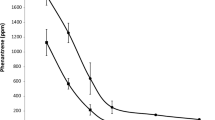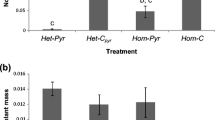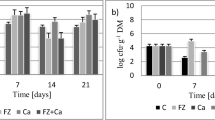Abstract
The influence of red clover (Trifolium pratense L.) plants on the decomposition of phenanthrene and octadecane in the soil has been studied. Effect of plant root mass on the abundance of hydrocarbondegrading bacteria, the composition of their communities, and the degradation of hydrocarbons in the soil has been revealed. Changes in the taxonomic composition of hydrocarbon-degrading bacteria under the effect of red clover are characterized by an increase in the abundance of species from the genera Acinetobacter, Kaistia, Novosphingobium, Pseudomonas, and Xanthomonas. A positive effect of the studied microbial–plant association on the degradation of octadecane and especially phenanthrene in the soil has been revealed.
Similar content being viewed by others
References
M. A. Baboshin, B. P. Baskunov, Z. I. Finkelstein, E. L. Golovlev, and L. A. Golovleva, “The microbial transformation of phenanthrene and anthracene,” Microbiology (Moscow) 74, 303–309 (2005).
GOST (State Standard) 12038-84: Agricultural Seeds. Methods for Determination of Germination (Izd. Standartov, Moscow, 2004) [in Russian].
G. V. Zaalishvili, G. A. Khatisashvili, D. Sh. Ugrkhelidze, M. Sh. Gordeziani, and G. I. Kvesitadze, “Plant potential for detoxification (review),” Appl. Biochem. Microbiol. 36, 443–451 (2000).
J. H. Miller, Experiments in Molecular Genetics (Cold Spring Harbor Lab., New York, 1972).
A. A. Ovchinnikova, A. A. Vetrova, A. E. Filonov, and A. M. Boronin, “Phenanthrene biodegradation and the interaction of Pseudomonas putida BS3701 and Burkholderia sp. BS3702 in plant rhizosphere,” Microbiology (Moscow) 78, 433–439 (2009).
E. P. Rozanova and T. N. Nazina, “Hydrocarbon-oxidizing bacteria and their activity in oil reservoirs,” Mikrobiologiya 51, 324–348 (1982) [in Russian].
A. M. Semenov, Ecology of Microorganisms, Ed. by A. I. Netrusov (Akademiya, Moscow, 2004), pp. 145–164 [in Russian].
T. A. Sokolova, “Specificity of soil properties in the rhizosphere: analysis of literature data,” Eurasian Soil Sci. 48, 968–980 (2015). doi 10.1134/S1064229315050099
Yu. V. Titov, The Plant Group Effect (Nauka, Leningrad, 1978) [in Russian].
E. N. Tsyganova, D. G. Zvyagintsev, L. V. Lysak, and A. L. Stepanov, “The effect of a bacterial-humus preparation on the biological activity of soils,” Eurasian Soil Sci. 46, 788–792 (2013). doi 10.1134/S1064229313070107
L. N. Anan’ina, O. V. Yastrebova, V. A. Demakov, and E. G. Plotnikova, “Naphthalene-degrading bacteria of the genus Rhodococcus from the Verkhnekamsk salt mining region of Russia,” Antonie van Leeuwenhoek 100 (2), 309–316 (2011). doi 10.1007/s10482-011-9580-3
A. Cébron, B. Louvel, P. Faure, C. France-Lanord, Y. Chen, J. C. Murrell, and C. Leyval, “Root exudates modify bacterial diversity of phenanthrene degraders in PAH-polluted soil but not phenanthrene degradation rates,” Environ. Microbiol. 13 (3), 722–736 (2011). doi 10.1111/j.1462-2920.2010.02376.x
J. L. Kirk, J. N. Klironomos, H. Lee, and J. T. Trevors, “The effects of perennial ryegrass and alfalfa on microbial abundance and diversity in petroleum contaminated soil,” Environ. Pollut. 133, 455–465 (2005). doi 10.1016/j.envpol.2004.06.002
I. Kuiper, E. L. Lagendijk, G. V. Bloemberg, and B. J. Lugtenberg, “Rhizoremediation: a beneficial plant microbe interaction,” Mol. Plant-Microbe Interact. 17, 6–15 (2004).
PubChem Compound. http://www.ncbi.nlm.nih.gov/ pccompound.
J. A. Rentz, P. J. J. Alvarez, and J. L. Schnoor, “Repression of Pseudomonas putida phenanthrenedegrading activity by plant root extracts and exudates,” Environ. Microbiol. 6, 574–583 (2004). doi 10.1111/ j.1462-2920.2004.00589.x
L. E. Rice and B. B. Hemmingsen, “Enumeration of hydrocarbon-degrading bacteria,” Methods in Biotechnol. 2, 99–109 (1997).
J. Seo, Y. Keum, and Q. Li, “Bacterial degradation of aromatic compounds,” Int. J. Environ. Res. Public Health 6, 278–309 (2009). doi 10.3390/ijerph6010278
J. D. van Hamme, A. Singh, and O. P. Ward, “Recent advances in petroleum microbiology,” Microbiol. Mol. Biol. Rev. 67, 503–549 (2003). doi 10.1128/MMBR.67.4.503-549.2003
S. R. Wild and K. C. Jones, “Organic chemicals entering agricultural soils in sewage sludges: screening for their potential to transfer to crop plants and livestock,” Sci. Total Environ. 119, 85–119 (1992). doi 10.1016/0048-9697(92)90258-T
S. Yousaf, V. Andria, T. G. Reichenauer, K. Smalla, and A. Sessitsch, “Phylogenetic and functional diversity of alkane degrading bacteria associated with Italian ryegrass (Lolium multiflorum) and Birdsfoot trefoil (Lotus corniculatus) in a petroleum oil-contaminated environment,” J. Hazard. Mater. 184, 523–532 (2010). doi 10.1016/j.jhazmat.2010.08.067
Author information
Authors and Affiliations
Corresponding author
Additional information
Original Russian Text © A.V. Nazarov, E.A. Shestakova, L.N. Anan’yina, 2017, published in Pochvovedenie, 2017, No. 8, pp. 1002–1008.
Rights and permissions
About this article
Cite this article
Nazarov, A.V., Shestakova, E.A. & Anan’yina, L.N. Effect of red clover on the microbial transformation of phenanthrene and octadecane in the soil. Eurasian Soil Sc. 50, 971–976 (2017). https://doi.org/10.1134/S1064229317080087
Received:
Published:
Issue Date:
DOI: https://doi.org/10.1134/S1064229317080087




